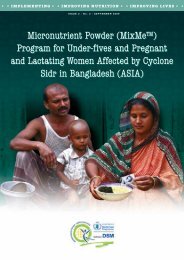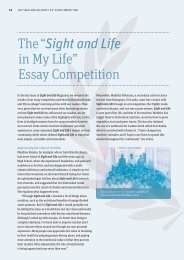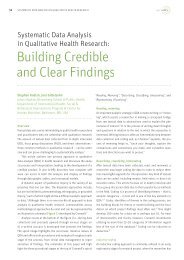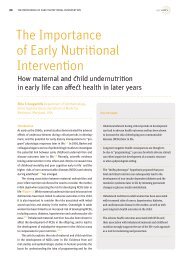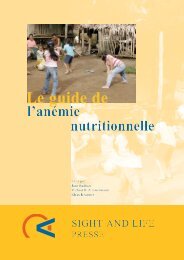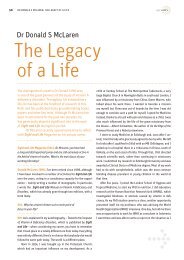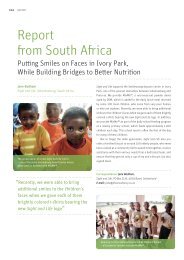Sight and Life Magazine 1/2011
Sight and Life Magazine 1/2011
Sight and Life Magazine 1/2011
You also want an ePaper? Increase the reach of your titles
YUMPU automatically turns print PDFs into web optimized ePapers that Google loves.
SIGHT AND LIFE | VOL. 25 (1) | <strong>2011</strong> OPINION 1 5555Opinion 1: Comments on “Iron Fortification– New Revelations?”Glenn GibsonDepartment of Food <strong>and</strong> Nutritional Sciences,University of Reading, United KingdomThe decision to withdraw iron supplementation in certain malaria-affectedareas was the subject of David Thurnham’s objectiveassessment of recent science findings. David has outlined someof the thinking behind this decision <strong>and</strong> input his own evidencebasedviews.As with so many current nutritional concepts, the drift of attentionhas been drawn to the gut microbiota. This is not surprising,given the vast numbers of bacteria that use the human alimentarytract as their home <strong>and</strong> their concomitant major impactupon metabolism. I especially like David’s conclusion that it isnot enough nowadays to simply measure predominant gut floracomponents without an assessment of the functional or physiologicalimpact. Perhaps some bacteria not present in largenumbers can exert a major impact upon health. In this context,“It is not enoughnowadays to simplymeasure predominantgut flora componentswithout an assessmentof the functional orphysiological impact”I have always been struck by the fact that it is easily accepted,by science <strong>and</strong> medical communities, that just a few cells of apathogen like E. coli 0157 can exert destructive effects, yet theimpact of a larger number of probiotic microbes gets writtenoff, more often than not. The science of metabonomics recentlyentered the gut microbiology arena <strong>and</strong> offers a similar “revolution”in our underst<strong>and</strong>ing of the impact of gut microbes to thatgenerated by molecular-based assessments of composition inthe last decade. 1On that note, David cites an extensive study which led to thecontentious decisions on iron supplementation. High throughput<strong>and</strong> accurate PCR-based technologies were used to assessthe gut microbiota in Ivorian populations. 2 These were seen todiffer markedly from European profiles, although parallel studieswere clearly not feasible <strong>and</strong> differing techniques may havebeen used. That aside, it seemed that the Ivorians harboredhigher levels of enterobacteria <strong>and</strong> lesser populations of Grampositive bacteria said to be beneficial (bifidobacteria). The ironuse was said to fortify the enterobacteria, <strong>and</strong> that led to healthissues. It is worth noting that these are facultative, rather thanstrict, anaerobes whose enhanced growth rates are likely ableto allow better scavenging of iron. I was also struck by the detectionof salmonellae <strong>and</strong> shigellae. These are clear pathogenswhich often only exist in a transient manner. In European trialsthey are hardly ever reported unless in association with a foodsafety outbreak. Perhaps this is the key to the health difficultiesseen, <strong>and</strong> maybe those few probiotics that boost bifidobacteria<strong>and</strong> consequently decrease pathogens are worth trying. 3 Microbiotamodulation through probiotics or prebiotics is popular inEurope, North America <strong>and</strong> Asia, but it seems to me that theIvorian children studied here could be major benefactors of aharmless intervention.David also gives us an example of how functional microbialassessments are needed rather than just compositional. Theclostridia were seen to exert varying effects upon inflammation⇢



